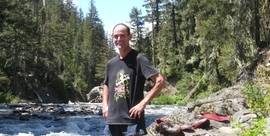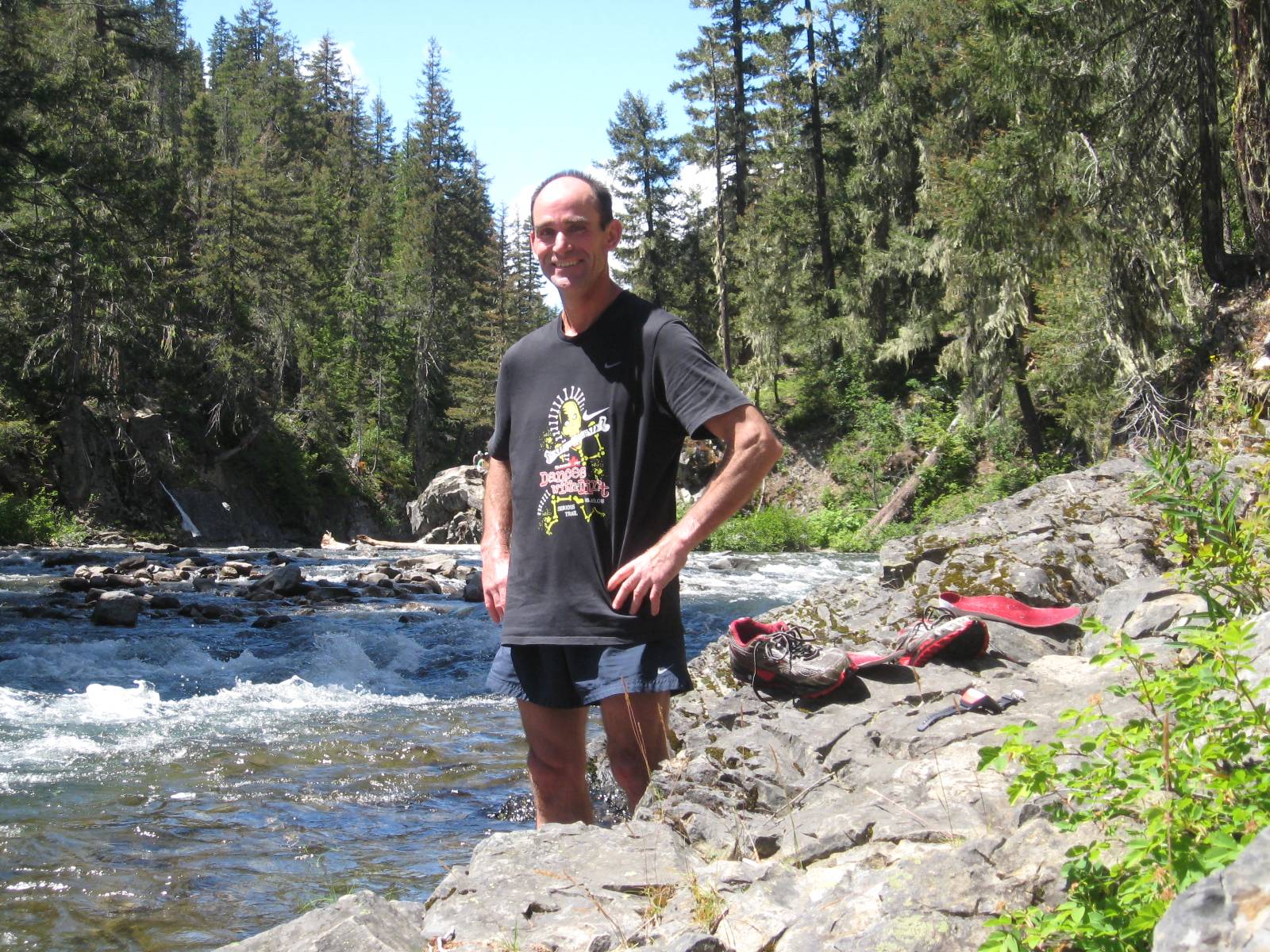
Matt soaks his feet in snow melt after twenty miles in the Cascades.
Matt Snyder’s competitive running career came to an end at approximately 11:07 a.m. on July 4, 2012. Why 11:07? The 54-year-old had just completed the first mile of the Champaign County Freedom 5k when he looked down at his watch. He thought he said, “Oh shit!” He’d planned on running an eight-minute mile. Instead, he blacked out.
Eight point six seconds after he collapsed, Matt’s eyes reopened.
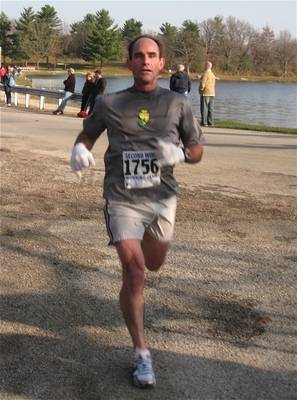 Any of you who ran the race slower than a seven-minute mile pace might have seen Matt. He was the shirtless (always shirtless) runner along the side of the road, blood gushing from the back of his head. A two-week-old sutured opening the width of an old-school silver dollar just below his left collarbone.
Any of you who ran the race slower than a seven-minute mile pace might have seen Matt. He was the shirtless (always shirtless) runner along the side of the road, blood gushing from the back of his head. A two-week-old sutured opening the width of an old-school silver dollar just below his left collarbone.
When Matt passed out, his heart hadn’t stopped. It couldn’t. It had been twitching at 330 beats per minute. Although technically still beating, it pumped no blood through his body. Without the implantable cardioverter defibrillator (ICD) in his chest he would be dead.
The story of Matt’s final race is less about what happened on July 4, and more about what happened in the weeks before it. Matt’s a runner, so it’s no surprise to any of us who have run with him that he would be out on the road in 100 degree heat, two weeks after an ICD was implanted in his chest.
The story is that no matter how fit you are, how able you are to run hundreds, no, thousands of miles a year, sometimes the body just doesn’t do what you want it to anymore.
Matt Snyder is, was… It’s still hard for me to think of his running in the past tense… Was one of the fastest 50+ year olds I know. He’s no longer fast. Oh, he could probably run a sub-seven minute mile if he had to, but as he explained in our talk, he’d fall down again, faint, only to wake up 8.6 seconds later. That’s the time it takes his ICD’s capacitor to charge up and shock his heart into beating normally again. Any time he reaches race pace now, things go dark.
It all started in May of 2012. Matt ran a 25 miler in Colorado that month, and things were OK. He ran a decent race at Lake Mingo, then the always uncomfortable Memorial Day 5k in Danville. It wasn’t until the following week during a track workout of 800s or 1200s when things didn’t feel right.
“I got dizzy, and so I kinda pulled off. Like real dizzy. Not just vertigo,” he said. But as soon as he stopped, he was fine again. In describing it later to his girlfriend, Dawn Carson (an age group, award-winning runner in her own right), Matt said, “It felt like my heart skipped a bunch of beats.”
Like with most men, it took some convincing, but Matt eventually went to his primary care physician for an EKG, who sent him to a cardiologist at Carle.
“They’re not ready for you and me,” Matt said. The “they” here are doctors, and the “you and me” are fit people. Cardiologists see the aged, those like my father who suffered from congestive heart failure. If a runner needs to see a cardiologist, the shit has hit the fan, so to speak. “I’m the age of the people bringing the other people in,” Matt said.
While he was with the cardiologist, they put him through a stress test. Here he was thinking, OK, I’ve got this. One U of I athlete runner lasted 21 minutes on the machine. It speeds up and increases the incline. I’ve done it before. It’s definitely a workout. Matt lasted 19 minutes and change. All good, right?
A normal heart forces as much as 65 percent of the blood out of itself with each beat. It’s called ejection fraction. Matt’s heart pumps in the mid-30s. There were other issues too, like a weird wall motion and the size of his heart’s chamber. But it always came back to, “but he’s a runner.” Yet after the stress test, the urgency for more tests grew.
Matt’s daughter, Hannah, is a third-year medical student at the University of Chicago, and she drove down for Matt’s heart catheterization, where they sneak an imager through arteries up into the heart to check for blockages. It was at this point, with all of the immediacy and worry around him, that Matt started to worry too.
The test showed everything was fine, but when Matt was in recovery, talking to Dawn and Hannah, alarms started going off on all the machines he was hooked up to. His heartbeat shot up to 180 per minute.
An electrocardiologist, a doctor who focuses on all things electrical in the heart, scheduled an EP study, another catheterization that stimulates the heart electrically to see what it will do. “They were wildly successful,” Matt laughs. “They got it to fibrillate. No one comes out of fibrillation on their own. In the old days you died.”
Matt had been in the hospital for four days when the electrocardiologist suggested the ICD. The device itself is mostly flat with two wires that snake out from it. Those wires are fed through veins to the heart to stimulate it when necessary.
“You can feel the wires,” Matt said as he rubbed his fingers near the scar. If he were heavy, they would have placed the unit under his fat layer and outside his pectoral muscle. Since he’s a runner and fit, they pulled the muscle away from the ribs and put it in the “pocket” behind his muscle.
“Oh my god, I was so messed up. I couldn’t move. This whole side of my body was all bruised,” Matt said, referring to his left side. “He (the doctor) said you ought to be good to go. Conduct your life like normal. There shouldn’t be any issues. You can run. You can do whatever you want.”
That’s why Matt was out there on the Fourth of July. He wasn’t doing anything he shouldn’t have been. I know what people are thinking. He’s two and a half weeks out from surgery. He just got a pacemaker. I know it because these were conversations I was having with people that day, standing at the finish line celebration, eating watermelon, and sipping Gatorade. People were like, why is he out here in 100 degree heat?
He’s out there because he’s a runner, and that’s what runners do.
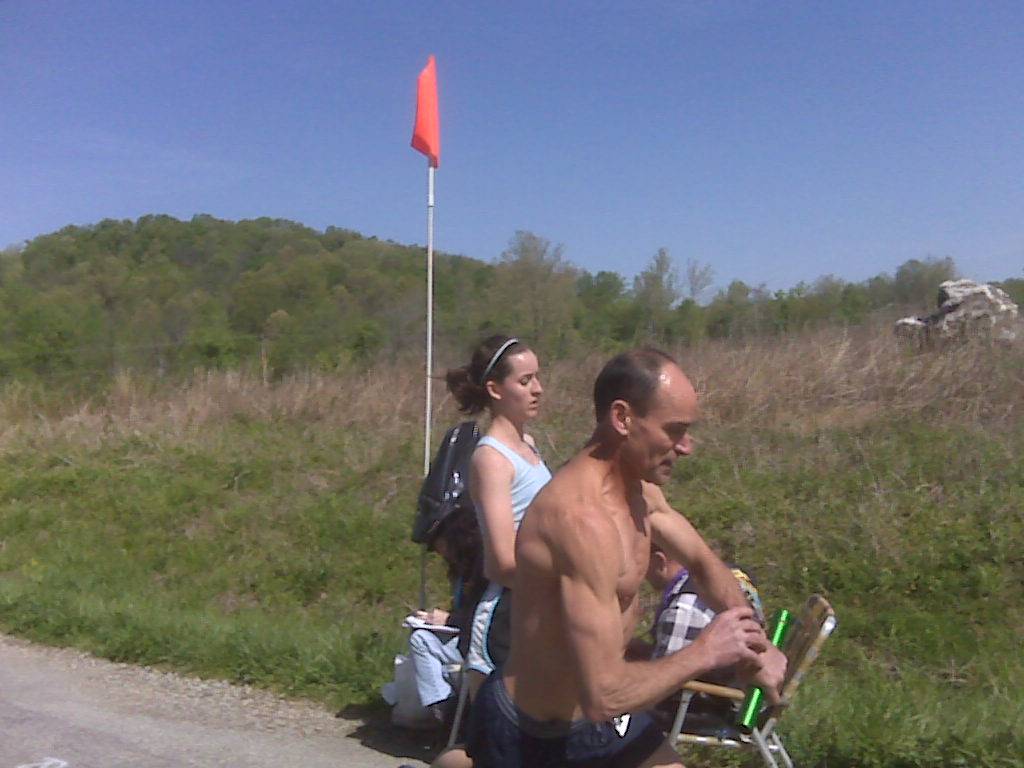
Matt receives the baton from his daughter, Hannah, during the 2010 River to River relay.
When Matt was on the ground, people thought he was overheated, but the fresh wound on his chest gave it away to others around him that he had an ICD in him.
Was it the device that failed on race day? Was it faulty?
After he came to, there was another trip to the hospital where Matt got staples for the wound to the back of his head. Then he and the local device manufacturer representative, Boston Scientific’s technician, wagered on whether the device misfired or Matt’s heart fibrillated. Matt lost. It was his heart, not the device.
Still, Matt’s doctor thought it was a fluke, that it was a coincidence that shouldn’t have happened. So Matt decided to test it out again a couple weeks after the July 4 race. Running on grass with Dawn’s son, Matt jogged to Meadowbrook. When they got there, they ramped up the pace to seven-minute miles: “I make it three quarters of a mile and bang. I’m out. The exact same thing. It’s not a coincidence.”
The doctors made some changes to the settings on the ICD, but Matt’s decided that he can’t run fast anymore. His racing days are over.
He still thought he could run though. Jog at the very least, just not race pace, but no. One day, Dawn and her daughter were riding bikes, and Matt was running alongside when it happened again.
There’s another procedure they can do called cardiac ablation where they scar the heart to destroy the tissue that is firing abnormally. Matt had that done, and it failed. Four times during the procedure, Matt’s heart stopped. “They expected to find the source of the arrhythmia at the right outflow track, the right lower chamber of the heart,” he said. “And it wasn’t there.”
One theory now is that Matt has arrhythmogenic right ventricular cardiomyopathy, or ARVC. It’s a genetic and progressive disease where the muscle of the heart converts into a fatty tissue. Each place where that happens is a potential spot for electrical leakage.
“My dad’s dad and two of his brothers all died before forty from heart problems. That’s 1940s, but you’ve got to work pretty hard to kill yourself before forty, no matter what your diet and activity level is. And so that makes it sound genetic,” he said. If he has that disease, it’s dominant, and Matt’s children will have a fifty percent chance of getting it.
After the cardiac ablation, the doctor told Matt that he can exercise moderately, so of course, two weeks later Matt and his son Jack went for a run. It was now late November. They went to Orchard Downs in Urbana: “A mile and a half warm up, roughly a mile speed, and I’m out.” A face full of grass.
At this point, it’s late November, and Matt’s heart has fibrillated nine times total. While running or while having tests done.
Four weeks ago, this is early February now, seven months since the Freedom 5k, and a doctor he consults at Northwestern says, “Stop. Stop running. Stop doing endurance stuff. Stop. Don’t bike.”
He can bike to the grocery store, but he can’t train. It’s over. Matt’s running career is done.
Obviously, he’d already suspected that after July; but like any runner, there was still that hope that something would change, and maybe a little denial. “I’m at that stage now, where I’m trying to figure it out. I have a fair amount of energy,” Matt says wryly.
I’ve known Matt for several years on the track. He used to organize the Second Wind Running Club’s speed workouts. To say Matt’s high-strung is an understatement. “And when you go from running forty- and fifty-mile weeks to stop doing everything, but my expectation of activity is…” Matt changes subjects easily. Talking about how if the genetic test is positive, his kids need to get tested.
Matt turned somber about runners and growing older, referring to the Wall Street Journal article titled, “One Running Shoe in the Grave: New Studies on Older Endurance Athletes Suggest the Fittest Reap Few Health Benefits.” It was an article that went around on the local trail running listserv last year.
At its heart, the article states that those who run faster and longer lose whatever health advantage they may gain over their non-running counterparts. The article reads:
Opinion is nearly unanimous among cardiologists that endurance athletics significantly increases the risk of atrial fibrillation, an arrhythmia that is estimated to be the cause of one third of all strokes. Chronic extreme exercise appears to cause excessive ‘wear-and-tear’ on the heart.
Essentially, “You can give yourself something that looks like ARVC,” by running, Matt said.
How has Matt coped with not running? It can’t be easy. I look at him and think here’s a guy that is just as fit as he was in May. There’s nothing to suggest by looking at him that he’s got a heart condition. In other words, he’s not my father, a man with tubes for oxygen to help him breathe. A man I hardly got to know growing up because of the time he spent in the VA sick. Matt is different. He is a runner.
What are Matt’s options for physical activity now that he can’t run? Archery, cricket, golf, and bowling, Matt said. “None of it sounds good. It’s hard to not do it.” Run, he means.
“I’m going to volunteer at my first race,” he says about the Earth, Wind, and Fire 5k in a week. He’ll run vicariously through Dawn. About competitive running, he said, “I miss that a lot. I don’t know how to cope with that. I haven’t gotten it, partially because I’m clinging to the possibility that something magical might happen. So I still think I’m healthy. I still feel healthy. So I can’t do the stuff that you normally do, the things that are available for most of us to compete.”
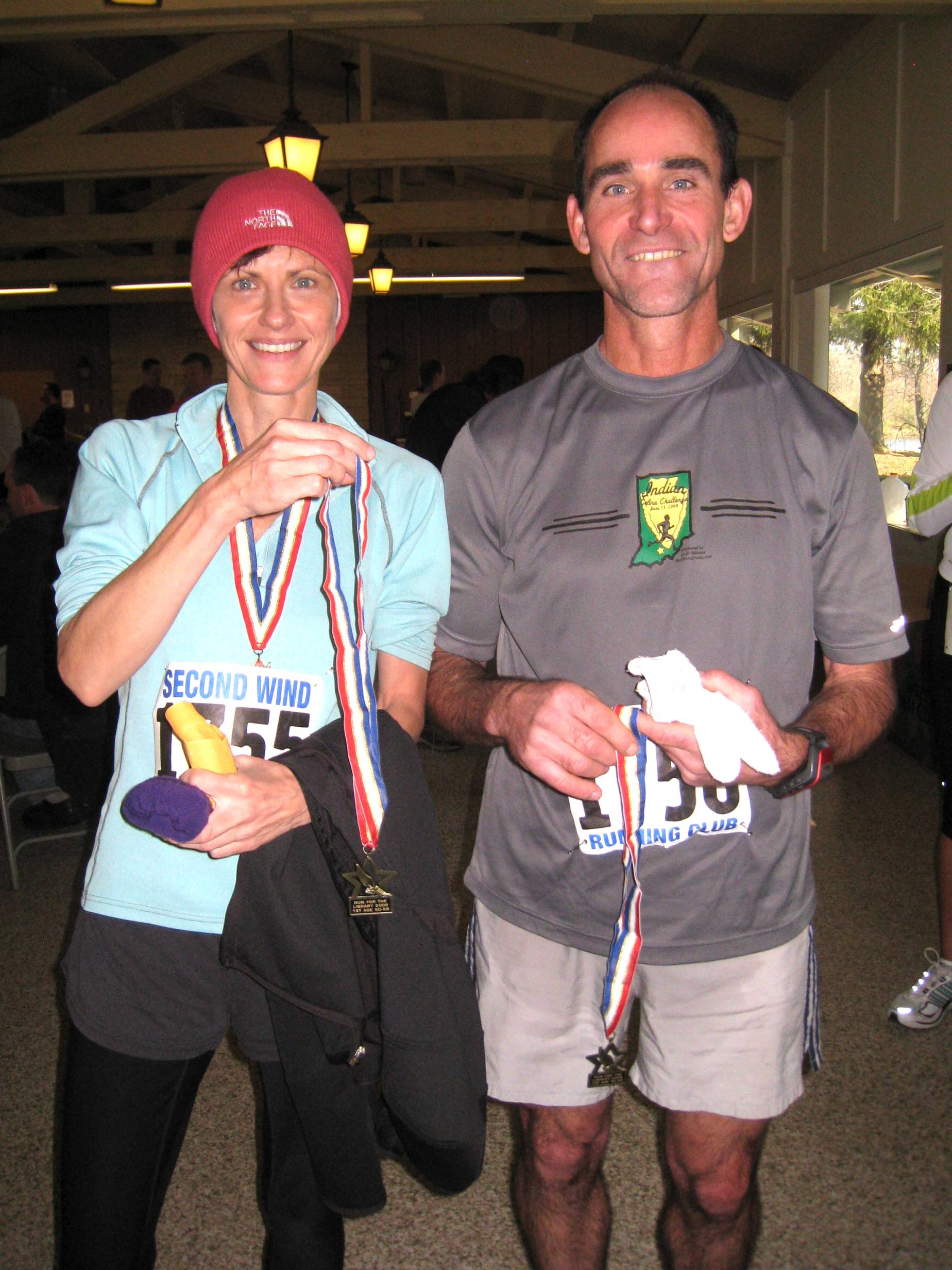
Dawn Carson and Matt pose with their race bling.
He can workout moderately, but what is moderate to a runner, someone used to competing at a high level? Eight-minute miles? Nine minutes? Ten? That might be considered too high level to a non-runner.
He’s got more energy at work, but that’s not the same thing.
Matt drove down to Charleston, Illinois, for the Charleston Challenge Mid-Winter Classic in February to support Dawn, who ran the 10k. “It was hard to watch. It was depressing to watch other people race,” he said. “It was selfish and immature.”
Matt faces a long road to acceptance. I can only imagine what he’s going through. He’s seven months out from his last race, and I could tell he wasn’t there yet. He still had that fire in his eyes, yet maybe not in his heart, his real heart, the one that beats too fast.
Like any serious, competitive runner, he’ll say, maybe not out loud, but he’ll think it: “I can still take you.”








